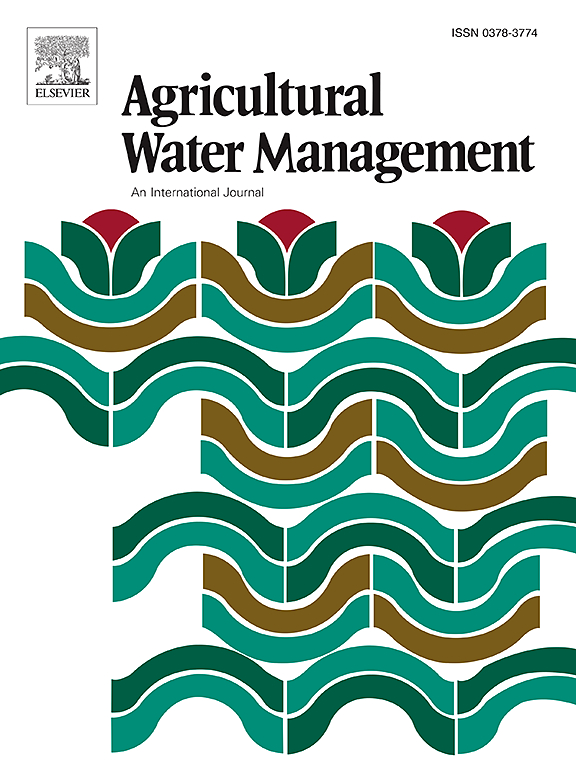浅层盐碱地下水和作物季滴灌及秋季收获后灌溉条件下玉米田土壤水盐动态的实验和数值评估
IF 6.5
1区 农林科学
Q1 AGRONOMY
引用次数: 0
摘要
在地下水盐度较浅的地区,由于灌溉和地下水盐分的上移,土壤中的盐分在作物生长期间不可避免地在根区积累。在华北地区,收获后通常会采用大水秋灌(AIR),以减轻土壤盐分对第二年作物生长的胁迫。在作物生长期和非生长期优化总灌溉深度具有挑战性,因为土壤盐分的移动受滴灌器周围二维分布的影响,以及冬季冻融循环的影响,对冬季水流和溶质迁移产生重大影响。本研究利用 2021 年至 2023 年在中国鄂尔多斯南岸灌区收集的试验数据,对 HYDRUS-1D 和 HYDRUS-2D 模型进行了集成和校准。模型集成评估了不同灌溉策略下玉米非生长期和生长期的土壤水盐动态:a)高(AH)和低(AL)灌溉深度的空中灌溉;b)高(DH)、中(DM)和低(DL)灌溉深度的滴灌(DIR)。结果表明,HYDRUS 有效地模拟了不同灌溉策略下饱和糊状提取物的导电率(ECe),其平均判定系数(R2)和均方根误差(RMSE)分别为 0.87 和 0.53 dS m-1。一般来说,使用直接灌溉(DIR)时,ECe 在生长期增加,而使用喷灌(AIR)时,ECe 在非生长期减少。在 0-40 厘米土层中,AIR 和 DIR 深度每增加 100 毫米,ECe 分别减少 5.7% 和 12%。与 AHDM 和 AHDL 处理相比,减少 AIR 深度和增加 DIR 深度可降低生长期 0-40 厘米土层的 ECe,提高作物产量(CY)和灌溉水生产率(WPI)。具体而言,在生长期间,ALDH 处理与 AHDM 处理相比,0-40 厘米层的平均 ECe 降低了 4.8%,CY 和 WPI 分别提高了 7.2% 和 10.3%。此外,当空气占总灌溉量的 35% 时,灌溉策略对降低 ECe 最有效。这项研究表明,将低灌溉面积和高密度灌溉面积结合起来可提高水分和田间生产力。本文章由计算机程序翻译,如有差异,请以英文原文为准。
Experimental and numerical evaluation of soil water and salt dynamics in a corn field with shallow saline groundwater and crop-season drip and autumn post-harvest irrigations
In areas with shallow saline groundwater, soil salts inevitably accumulate in the root zone during the growth period due to irrigation and upward movement of salts from the groundwater. In Northern China, autumn irrigation (AIR) with large amounts of water is commonly employed post-harvest to mitigate soil salt stress on crop growth in the subsequent year. Optimizing the total irrigation depth during both crop-growth and non-growth periods is challenging because of the movement of soil salts, which is influenced by their two-dimensional distribution around drippers and the impact of the winter freeze-thaw cycles, significantly affecting water flow and solute transport during winter. In this study, the HYDRUS-1D and HYDRUS-2D models were integrated and calibrated using experimental data collected from 2021 to 2023 in China's Ordos south bank irrigation area. This model integration was conducted to assess soil water and salt dynamics during the non-growth and corn-growth periods under different irrigation strategies: a) AIR with high (AH) and low (AL) irrigation depths, and b) drip irrigation (DIR) with high (DH), medium (DM), and low (DL) irrigation depths. The results indicated that HYDRUS effectively modeled the electrical conductivity of the saturation paste extract (ECe) across different irrigation strategies, yielding an average coefficient of determination (R2) and the root mean square errors (RMSE) of 0.87 and 0.53 dS m−1, respectively. Generally, ECe increased during the growth period with DIR and decreased during the non-growth period with AIR. For the 0–40 cm soil layer, ECe decreased by 5.7 % and 12 % for every 100 mm increase in the AIR and DIR depths, respectively. Compared with the AHDM and AHDL treatments, reducing an AIR depth and increasing a DIR depth resulted in lower ECe in the 0–40 cm layer during the growth period and higher crop yield (CY) and irrigation water productivity (WPI). Specifically, the average ECe in the 0–40 cm layer decreased by 4.8 % during the growth period in the ALDH treatment compared to the AHDM treatment, and CY and WPI increased by 7.2 % and 10.3 %, respectively. Additionally, the irrigation strategy was the most effective in reducing ECe when AIR accounted for 35 % of the total irrigation. This study suggested that combining low AIR and high DIR could enhance water and field productivity.
求助全文
通过发布文献求助,成功后即可免费获取论文全文。
去求助
来源期刊

Agricultural Water Management
农林科学-农艺学
CiteScore
12.10
自引率
14.90%
发文量
648
审稿时长
4.9 months
期刊介绍:
Agricultural Water Management publishes papers of international significance relating to the science, economics, and policy of agricultural water management. In all cases, manuscripts must address implications and provide insight regarding agricultural water management.
 求助内容:
求助内容: 应助结果提醒方式:
应助结果提醒方式:


